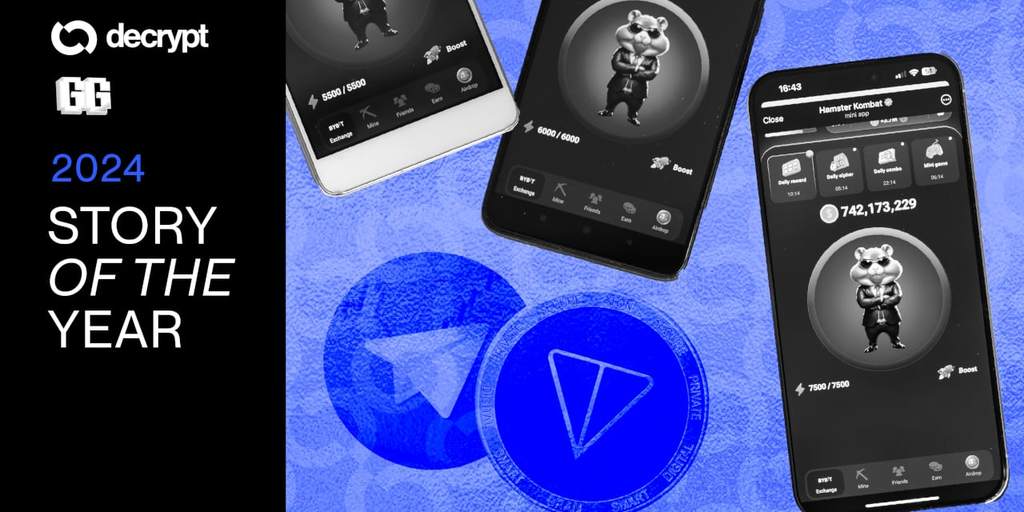
In early 2024, Telegram’s first tap-to-earn game was a curiosity – an enigma. By the end of the year, Notcoin’s success had spawned a mini-industry that had attracted significant demand. And yet, as quickly as Telegram gaming came, it went, and it increasingly feels like its moment has passed.
When Notcoin launched in January, we hardly knew what to think of it. Why were people incessantly tapping a coin in a messaging app on their phone? Could there be a real on-chain token, or was this just some kind of meta-commentary on the crypto world?
A real token was going to be minted on The Open Network (TON), and Notcoin chose to keep it simple: you tap and you earn. That simplicity, combined with an enticing anti-establishment atmosphere and growing momentum around TON, ultimately attracted 35 million players to the game in just three months.
By the time the Notcoin airdrop delivered hundreds of millions of dollars worth of tokens to players, and that value rose to billions of dollars within weeks, tap-to-ear was about to explode. And that’s where Hamster Kombat took over.
While Hamster Kombat was ultimately still built around a tapping mechanic, it shifted gears and took the form of a very streamlined management sim as you launched and grew your own crypto exchange – like a fluffy hamster, of course.
As crazy as that premise sounds, Hamster Kombat hit hard. Within a few months, the creators were boasting hundreds of millions of players as the game’s social media accounts soared.
And then things got weird.
Massage guns reportedly sold out in Russia as players used their rhythmic, repetitive vibrations to manipulate Hamster Kombat’s tapping gameplay. And in June, an Iranian military official denounced the game’s growing hold on players in the country, suggesting it would have implications for the looming presidential election.
“One of the hallmarks of the enemy’s soft war is the ‘Hamster’ game,” Iran’s deputy military chief Vice Admiral Habibollah Sayyari said, according to the state administration. IRNA news agency.
Telegram gaming had an impact on the real world, and by the time Hamster Kombat said it had attracted a total of 300 million players in July, other games like Catizen and Yescoin were also taking off with their own riffs on the premise.
A lot happened at the Hamster Kombat airdrop. A major success would confirm the viability of the tap-to-earn model and its repeatability – that Notcoin wasn’t a fluke, and that a game that penetrated the mainstream could still deliver that kind of value at scale.
Instead, as many players would claim via social media posts, they were given “dust.”
Hamster Kombat’s HMSTR airdrop in September gave players hundreds of millions of dollars worth of free tokens, effectively creating value out of thin air and rewarding players with real-world cryptocurrency. But with around 130 million players eligible for the airdrop, it wasn’t surprising to see people perhaps ending up with a few dollars worth of coins. And they were frustrated.
Every notable gaming airdrop from Telegram since Notcoin has been marked by similar discontent. In part, this is because the airdrops have become so much messier, rife with complications, as developers moved away from the simplicity of Notcoin and tried to monetize their players while moving them to other games to fuel the hype cycle.
For example, the cat-themed Telegram puzzle game Catizen angered quite a few players by changing its airdrop eligibility factors right before the tokens’ launch, heavily favoring those who had spent real money to pay for perks.
Tomarket said it held its token generation event in October, but the “tokens” issued to players would not be tradable until TOMA was listed by exchanges. Ultimately, the team admitted that it was an “in-game” token launch and that nothing had been minted on TON – and a week before the airdrop, Tomarket said that TOMA would be minted on Aptos instead.
As the year comes to a close, game makers like Tomarket and MemeFi are trying to explain to their players why their respective tokens aren’t worth much. Meanwhile, early Notcoin followers like Yescoin and Tapswap still haven’t launched their own tokens.
Hamster Kombat, meanwhile, is simply in limbo after the airdrop. The team teased an overhaul of “Season 2” with new gameplay, but missed the launch target by almost two months at the time of writing, with dwindling player numbers and fewer updates on the official Telegram channel. Now the team says it’s getting underway three games like a ‘HamsterVerse’.
Between repetitive gameplay, increasingly messy token launches and players burned by deceptive promises, the crypto industry’s attention has turned elsewhere in a more bullish market – back to Bitcoin and the rising meme coins.
Experts are mixed on the future of tap-to-earn games. Some have said that the games should be more engaging and robust; Others suggest that such simple tapping mechanisms should only be used as a tool for onboarding and engagement with new platforms and projects.
Tap-to-earn gaming has repackaged the 2021 play-to-earn craze, streamlining and simplifying the concept and making it more palatable to the masses. It worked, if only for a short time, but eventually many of the same underlying problems emerged.
Is the next Notcoin around the corner in 2025? Maybe. But players and creators alike learned some hard lessons from the initial boom, and any illusions about tapping into crypto wealth have quickly faded.
GG Newsletter
Get the latest web3 gaming news, hear directly from gaming studios and influencers in the space, and get power-ups from our partners.


